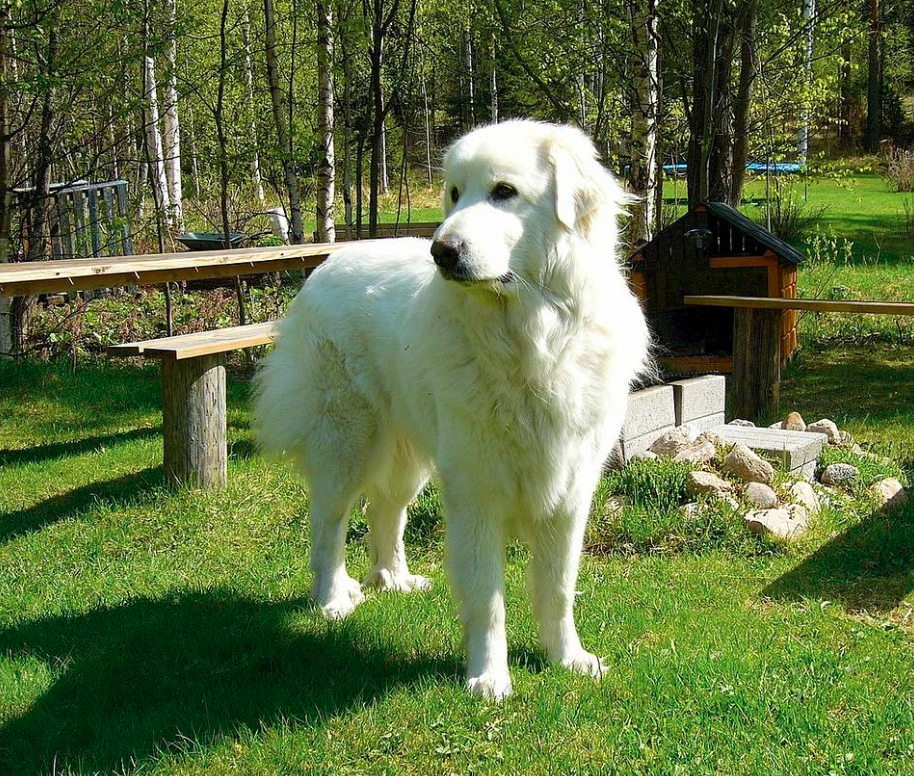The Great Pyrenees Newfoundland mix is known as a designer dog that combines the traits of the Great Pyrenees and the Newfoundland. Great Pyrenees is a giant breed having thick white fur and being laid back while Newfoundland are friendly and docile characterized by their smartness and adaptability. From these two combinations, the resultant dog is friendly, protective, and adaptable.
Size
The great pyrenees newfoundland mix comes with size; it is big like both its parents. They can weigh between 85-180 pounds and stand at an average height of 25-32 inches for the Great Pyrenees and 25-29 inches for the Newfoundland.
Temperament
The temperament of the Great Pyrenees Newfoundland mix results from two different parent breeds. They are known to be gentle, affectionate, good watch dogs, low grooming needs and low exercise requirements. They are also independent thinkers who may be hard to train but they like making their people happy so they are thought to be easy to train.
Exercise Needs
It requires moderate amounts of exercise ranging between 30-45 minutes of moderate exercise per day in case of Great Pyrenees Newfoundland mix. So, slow walk or some mild games or sports would suffice them for like between half an hour to one hour daily.
Grooming
For this crossbreed type called great pyrenees newfoundland mix, grooming could be regarded as intermediate due its thick double coat needing constant brushing and bathing too. They should take baths every other week not exceeding six weeks time span apart where else brush their fur every week or every other week so that it does not develop tangles on it.
Health and Safety
The health issues of Great Pyrenees Newfoundland mixes are comparable to their parent breeds’; chances include joint problems like hip dysplasia, arthritis, and elbow dysplasia. These breeds also tend to have skin disorders, eye diseases, ear diseases, stomach issues, cardiac ailments, blood clotting disorders, hepatic failings and osteosarcoma as well as Addison’s Disease. When planning to get a puppy from a litter it is advisable that one seeks advice from breeders who are known for carrying out DNA tests and examinations on the eyes as well as the hips and knees so that the pet may be healthy.
Origin and History
The mixed breed characteristics of these two breeds – The Great Pyrenees and Newfoundland, are traceable to the distinct origins, and histories from which they came.
Great Pyrenees originated in the Pyrenees Mountains which cut across Spain and France, where they were mainly used as guards for flocks from predators such as bears and wolves. Their ancestors can be traced back to Asia about 10,000-11,000 years ago; Europe was lucky to receive them just five thousand years ago. At first it was a peasant’s dog, associated with shepherds known for their extreme faithfulness both towards the shepherd and their family. They set foot into Newfoundland around mid-1600s where they could manage coping with harsh winters. The pureness of gene pool reduced as these natural predators became rare due to their breeding with other breeds. In 1907, French kennel clubs were established that targeted only pure bred Great Pyrenees so that dogs could be reproduced to maintain its existence.
Origin and History of Newfoundland Breed
Originating from the eastern part of Canada, Newfoundland breed is believed to have been bred in that country. The breed’s origin has been linked to a number of theories including that it may have descended from American black wolf or Tibetan Mastiff. This breed was used by Basque fishermen who sailed between their homeland and Newfoundland for draft purposes and as ship dogs. In the 18th and 19th centuries, English settlers on the island of Newfoundland were amazed by native dogs’ great size and strength, natural swimming ability, and gentle disposition. It got its name around 1775.
Facial Expression
Great Pyrenees and Newfoundland breeds were bred together to create Great Pyrenees Newfoundland mix. This hybrid breed combines protective nature and loyalty inherent in Great Pyrenees with adaptability and intelligence found in Newfoundland. For this reason, mix breed always finds favor among families and households.
With regard to face structure, the Great Pyrenees Newfoundland mix has a broadhead which is common with both parent breeds. They have a large mouth with rounded eyes; upper lip can be long like seen in one parent breed or short like seen in another. Ears can be long droopy ones like those in Newfoundlands or shorter upright ones similar to those possessed by Great Pyrenees. Tail is fluffy while legs are bushy.
Characteristics of Great Pyrenees Newfoundland Mix
Great Pyrenees newfoundland mix is a calm and gentle dog that has loyalty as well as protection traits. They are great with children but may develop separation anxiety if left alone for extended periods . Among designer dogs it is not very popular crossbreed therefore no kennel club or similar organization can register it .
The Great Pyrenees Newfoundland mix is a special case of a dog because it has inherited its temperamental traits from both parents. The Great Pyrenees dogs on the other hand are calm, patient and composed while Newfoundlands have friendly and sociable temperament.
They are also friendly in general which makes them good for families as they can even get along with cats because they are great with children. Despite this however, they may be protective towards their family members and show stranger anxiety especially if not properly socialized as puppies.
Workout
The Great Pyrenees Newfoundland mix is notable for its faithfulness and protectiveness, making it a pragmatic choice for keeping watch. In addition to being kind and patient, they are soft-hearted enough to be around children. But then again, they could be stubborn and independent-minded, needing steady guidance in their upbringing as well as early exposure in order to develop stable characters.
This breed of dog requires just moderate physical activities since the two parents have similar requirements. They like taking slow walks and playing games that do not require too much effort and can therefore be given between 30 minutes to one hour of exercise per day. On the other hand, these dogs may not necessarily need lots of exercises like some other working or herding breeds would because their workaholic traits were replaced with homebody traits.
Mental Stimulation Needs
In this regard too, mental stimulation is imperative as it helps them keep engaged which otherwise if not doing anything will lead into boredom due to being intelligent. To achieve this goal, training should be consistent using positive reinforcements so that desired behaviors become repetitive habits. They are highly cooperative when treated well thus making it easy while one is training them.
Great Pyrenees Newfoundland mixes should pass through socialization phase where they come across people who are not part of their family members since these breeds tend to be protective. Teach your young pups what is acceptable by exposing them to all sorts of places and experiences.
Living Environment and Climate Adaptability
The Great Pyrenees Newfoundland mix needs good housing space due to their large size plus exercising demands; the dogs themselves can fit into various living conditions ranging from urban areas up to the countryside provided there exists a free guard zone around for outdoor affairs. Since they are also protective animals, homes with sprawling yards or enclosed spaces where they can move freely and monitor their surrounding seem appropriate.
Grooming and Maintenance Needs
On climate adaptability note, these dogs thrive in various weather conditions because of their double coats that keep them warm during cold seasons and cool through the hot ones. It is, however, not advisable to shave them during summer heat as the coat helps them regulate their body temperature and protect against the sun. They shed quite a bit and therefore need grooming at least for thirty minutes once per week just so they can avoid this issue. Furthermore, they should be shampooed twice a month using high quality dog products to prevent stripping their skin or hair of essential oils while its ears, teeth, nails as well as fur are kept under scrutiny to ensure no inflammation, infections or parasites exist.
Unique Qualities and Versatility of the Breed
The Great Pyrenees Newfoundland mix is a one-of-a-kind hybrid that comes from the combination of both parents’ best characteristics, producing a faithful, smart and sociable companion. They are big and majestic canines that require moderate physical activities as well as some mental exercises hence making them good for families and individuals who can offer them affectionate care riddled with motion.
These dogs possess the ability to adapt to various climates and living conditions, while their grooming requirements are also minimal, thus making them an all-round dog breed that can exist in a variety of habitats. Their defensive behavior added to their kind-heartedness and imperturbability makes them great watch-dogs and members of family at large..
Socialization and Training
For them to have a stable temperament and be well behaved in different situations, it is important that they go through proper socialization and training. By using positive reinforcement training and having early socializing, this dog will become an obedient and well-mannered companion.
Conclusion: The Great Pyrenees Newfoundland Mix
Finally, the Great Pyrenees Newfoundland mix is one of the most special breeds that combine loyalty, intelligence and friendliness perfectly. This breed can sure make a great family pet or companion; we hope readers would consider them as such since their presence in any household would be matched by nothing less than joyousness with companionship.

